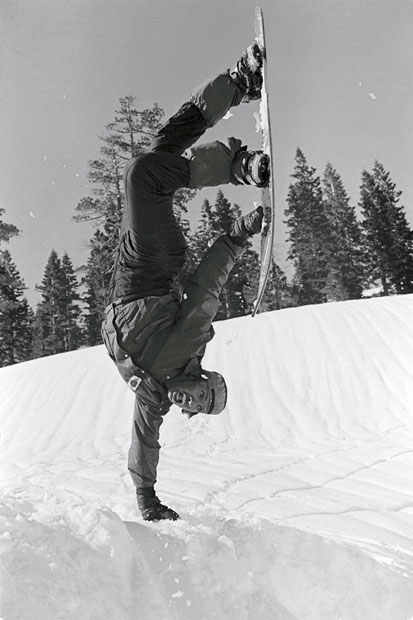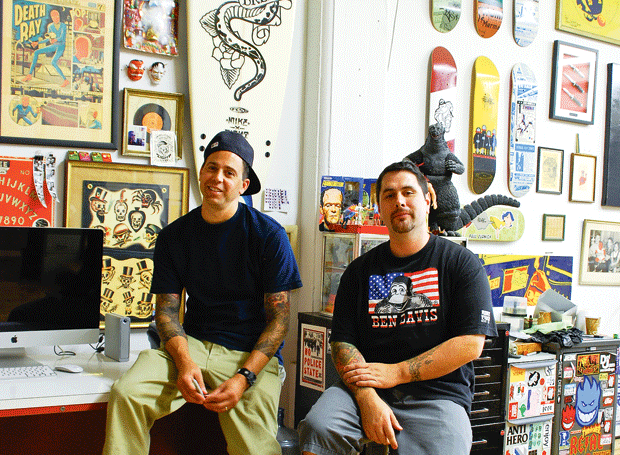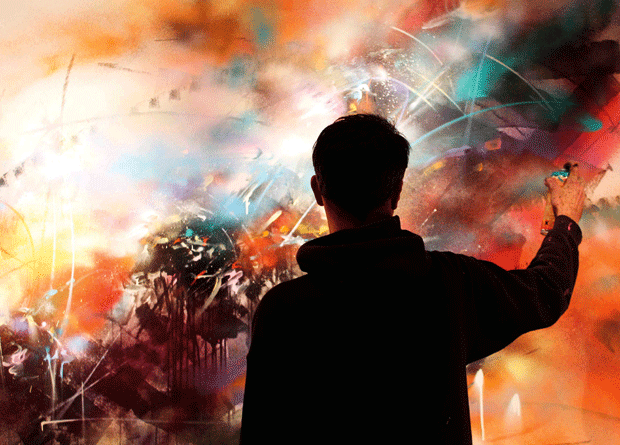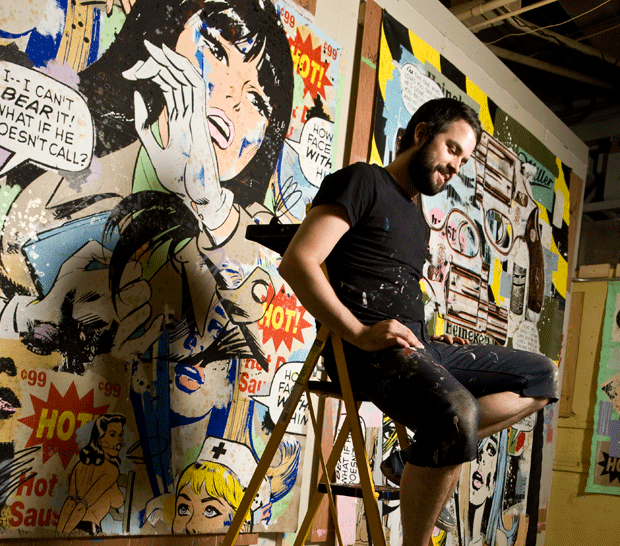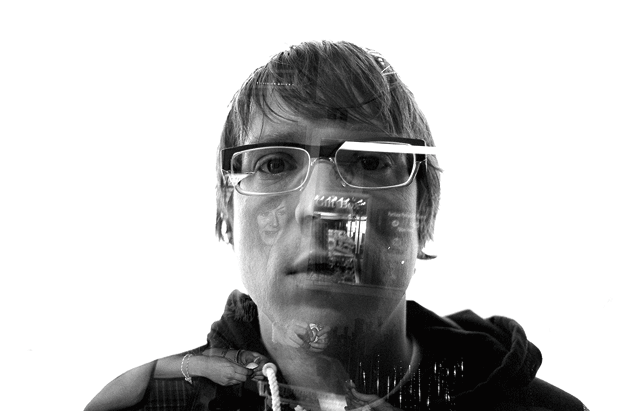Published in Whitelines Magazine Issue 93, December 2010
Words: Tristan Kennedy
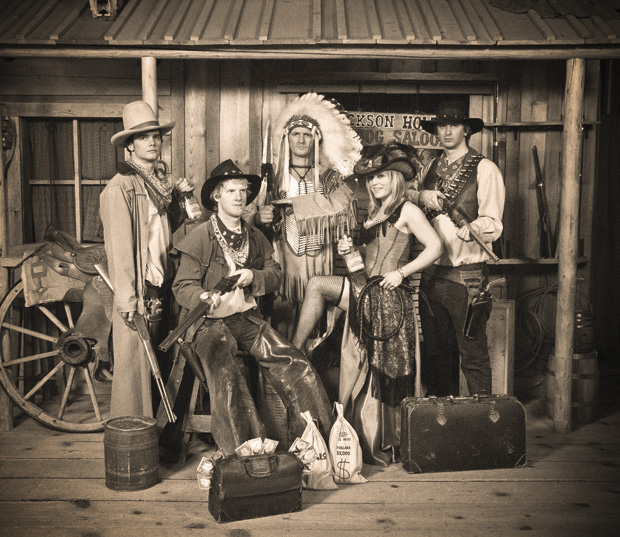
The lights dim as the plane comes in to land, turning the inside of the cabin the same dusky purple colour as the sky outside my window. Peering through the porthole for the first time since the sun went down, I strain my eyes to make out something of the empty-looking landscape. Are those fuzzy black dots villages? Farms? Houses? Maybe even a particularly massive moose? There’s hardly a single light to break up the white, snowy surface and it’s pretty difficult to get any sense of scale. And then, minute or two before the tyres hit the tarmac, I see them. Looming up seemingly out of nowhere, the enormous silhouette of the Tetons blocks out the last of the dying light from the sky, casting a deep, dark shadow over the flat floor of the valley. The stewardesses strap themselves in, and we drop into the emptiness of Jackson Hole.
Like many of the places ‘discovered’ by white people moving westwards into the American wilds, Jackson Hole got its name based on first impressions. As the first fur trappers and hunters entered the valley from the north, they were struck by the incredible steepness of the slopes, which gave them the impression that they were climbing down into a hole. One of these early hunters – a Mr Davey Edward Jackson – christened the area, using the same streak of brilliance that lead pioneers in Washington State to call a town ‘Big Lake’. It must have been around the same time that an atypically sex-starved Frenchman decided the three mountains looked like tits – tétons in French. While I struggle to see how the rocky peaks could ever really have resembled breasts, two hundred years later I too find myself impressed by how suddenly they seem to rise up from the valley floor. Even from down here on the ground, where scale should be easier to judge, they look impossibly large. It’s not just the mountains that have remained largely unchanged by the passing of time: My method of entry (American Airlines from Heathrow via Dallas) may be somewhat easier than the arduous approach taken by Edward Jackson and his friends, but the archway of antlers that greets me at the door of tiny terminal building and the sign over the baggage conveyer belt: ‘ALL GUN CASES MUST BE CLAIMED AT THE TICKET COUNTER’ leave me under no illusions – this is still hunting country.
An atypically sex-starved Frenchman decided the three mountains looked like tits – tetons in French.”
While hordes of eager gun-lovers still pass through Jackson Hole to this day, it is a different sort of hunting that has brought myself out here with Colum Mytton, Jenny Jones and Sam Cullum. Those same steep slopes that protected this secluded valley and its animal population – keeping it popular with hunters – have made it into a Mecca for another kind of thrill seeker in the late 20th century. Rising up from 5,000 metres to nearly 7,000 metres, the Tetons boast a gradient that is steeper than almost anything else in the Rockies. So it’s little wonder that snow lovers have been flocking to the town ever since the first rickety lifts were installed in the 1930s. But it’s in the last couple of decades that mountain’s reputation as a centre of serious gnarl has really grown – at least among snowboarders. It was here that Volcom legend Bryan Iguchi chose to retire to when he quit riding contests. It was also here that talented young French rider Tristan Picot was tragically killed in an avalanche while filming for Absinthe in 2003. And it was here that Travis Rice filmed a large part of his genre-defining epic, That’s It, That’s All. In fact, Travis, a Jackson Hole native who perfected his big balls-out riding style on this unique terrain, has probably done more to promote Jackson amongst the snowboarding community than almost anyone else. It is this reputation, and these modern legends, that have brought us out here.

“So where do you spend most of your winters then?” Bryan ‘Guch’ Iguchi asks as I bounce along the uneven tarmac towards the resort in the back of his truck. Next to Guch, also half-turning to hear my answer, is equally legendary rider Johan Olofsson. We’ve hooked up with these two thanks to Vernon Deck, who (when he’s not travelling with Whitelines) is Volcom’s official snow photographer. Between them, Johan and Guch have probably straight-lined more Alaskan faces than I’ve eaten hot meals. While neither of them are the biggest blokes, the sheer size of their reputations is pretty intimidating. I feel my mouth go strangely dry. “Erm, well, these days I guess I spend most of the winter in er… London.” “Riiiight.” Dammit, what kind of a shit answer is that? I’m kicking myself. Where was the cool, casual conversation I’d had in my head when I got in the car? I mutter something about having spent seasons in France and heading out to Austria later in the year, but in my mind the damage has already been done. “What the hell is this park-rat city-boy doing out here in the wilderness?” they must be thinking. Turns out I needn’t have worried at all. Guch and Johan turn out to be chilled as anything, without so much as a hint of ego between them. And they’re the best possible guides to the mountain. Johan may be a man of few words, but he has an easy smile and a friendly way of bringing up the back of the group, making sure everyone’s OK. Guch meanwhile comes across like a favourite bearded uncle. He leads the way, pointing out all the notable spots (“down there that’s the Terje Hit”) suggesting lines to ride and making sure everyone feels welcome in the stunning landscapes of his chosen home.
Having already spent a couple of days exploring the mountain, I figure Col and Sam have already got their snow legs on. But it’s amazing what a difference having Guch around makes to everyone’s riding. After a quick avalanche beeper check, we cut across the pistes and duck under the ropes into the ‘out of bounds’ area. Jackson’s reputation – and the locals’ insatiable Chamonix-style appetite for pow – means that everything inside the patrolled boundary line is tracked out within hours of a fresh snowfall. Out here however, there’s still enough fresh to get a rooster tail of spray every few turns. We stop at the top of a sizeable cliff, which Guch suggests hitting for a photo. The drop is bigger than the one Sam and Col had shied away from hitting the previous day, but something about Guch’s easy-going attitude and calm reassurances mean that both of them are soon boosting off the 25-foot drop with complete confidence – Col even goes for a front 7 on his second hit! Sitting in the sun underneath the cliff band snapping photos, it seems strange to think that the little dude up there encouraging my friends is a snowboarding legend. That is until he drops in and floats a perfectly tweaked Iguchi method off of the hit.
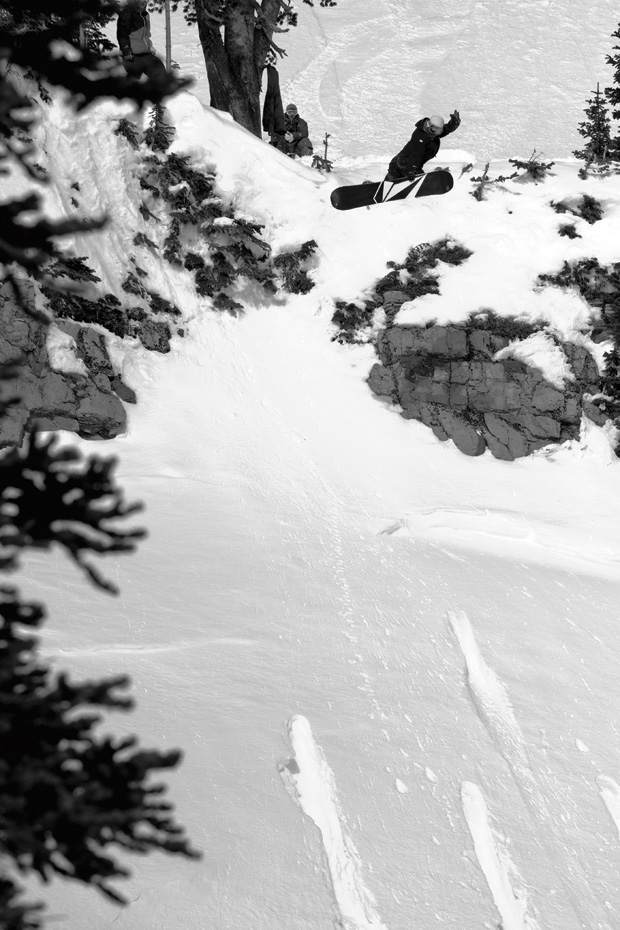
A stiff hike (and a ciggie stop for Col) later, and we find ourselves on the top of a long ridge flanked by fir trees. To our left, on the other side of the valley we’ve just ridden through, we can see the resort boundary. To our right, across a similar valley, a slim finger of mountain stretches down to touch the flat floor of the Jackson basin. Beyond that, what looks like two or three more fingers are reaching out, each longer than the last, and each covered in the kind of evenly spaced trees and fun-sized rock drops that make for perfect backcountry riding. Not only is this massive zone easily accessible, but it’s pretty much set-up for people to come out here – there was a well-trodden bootpack trail up to the ridge we’re standing on, and someone (a helpful local? The resort management?) has attached a blood-wagon to a nearby tree – just in case.
We drop down into the valley, following Guch and Johan down towards the trees and kicking up sprays of the soft, fluffy snow. It’s been a few days since there was any new snowfall, but the cold continental conditions means what’s still here has stayed light and fluffy. People have been here before us, but there’s still enough pockets of fresh for Col, Sam and Guch to boost into for Vern’s watching camera-lens. Johan appears less interested in performing for the sake of a photo. He’s riding a simple red split swallowtail, with a few scattered stickers from places he’s travelled, but no obvious endorsements. In fact, he tells us his only major sponsor these days is The North Face, and they expect very little from him in return for their cash. Which is just as well, because the Swede has pretty much turned his back on the commercial side of snowboarding altogether, and rides by his own rules these days. You can point a camera at him if you like but he’s not going to stand around waiting to get a shot. Instead, he spends his seasons visiting old friends and enjoying the simple pleasures of riding with them. All of which makes Jackson Hole, and its unpretentious freeride-loving locals, the perfect place for him. When we visit, he’s been staying with Guch’s young family in their bungalow for several weeks, and looks set to stay for a few more.

Not that everyone in Jackson Hole is as unflash as these two. Guch’s house nestles among the trees along a strip of highway that connects the main road from Jackson to the slopes. Most of the dwellings along this stretch have battered trucks in the driveways, with well-worn snowmobiles parked in the back. There are working ranches scattered around – proper cowboy ones with gatepost signs dangling from wooden archways and horses standing forlornly around the bales of hay in the snow. But as you get closer to Teton Village, the cluster of houses, hotels and spas around the bottom of the Tram, things begin to look a little different. Signs offer “Deluxe Vacation Homes” in a chalet development called The Aspens (formerly known as the Jackson Racquets Club). Hotels offer five-star suites and valet parking for the SUVs that pull up at the entrance. From the Mangy Moose Saloon, the bar at the bottom of the slopes, we can just see the heated roof-top pool belonging to one of them, where the rich and beautiful lounge around in bikinis. “Looks alright up there doesn’t it?” says Col.
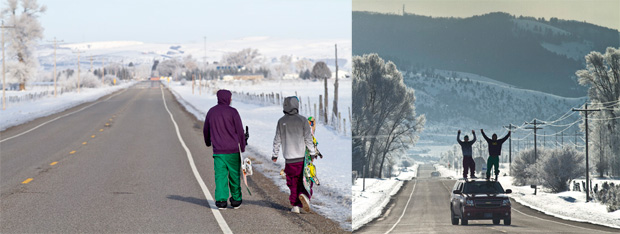
To be fair, where we stayed back in Jackson, a twenty-minute drive from Teton Village and the slopes, didn’t exactly suffer much in comparison. Our first couple of nights were spent in Snow King, a luxurious hotel complex on the edge of town that boasts its own private ski area right outside the door. Later on, we had the good fortune to stay in the Jackson Hilton, where we spent an amusing evening in the Jacuzzi with the daughter of a wealthy Californian businessman (who’s living in the Hilton for the season – not staying, living!) her jockish fiancé, her elderly father and her bratty younger brother – who seemed incapable of talking about anything other than the amount of weed he smoked. As well as being a hangout for the rad and the gnarly, Jackson Hole is also a playground for the rich and… well, the rich. George W’s Vice President Dick Cheney, a Wyoming native famed for his love of shooting shit, has a home there. Apparently the tiny airport used to be on lockdown for hours every time Air Force Two jetted in. But for every member of the country-club set in Jackson, there’s a local ranch-hand. And for every piece of modern cowboy kitsch added to attract the tourists there’s a Million Dollar Cowboy Bar – the iconic centerpiece of Jackson’s town square which has been serving liquor ever since it became legal in the 1930s.
I see a man in Stetson crouched over the bloody body of an elk- it’s intestines spilling out onto the snow and its dark, dead eyes glinting in the headlights”
It’s there that we head to the night before Jenny Jones arrives, hoping to catch the men’s Olympic halfpipe final, and soak up some of the atmosphere among the dead animal heads on the walls. In the end, it turns out that the Million Dollar Cowboy Bar doesn’t have a screen showing it, so we’re recommended the less hunting-happy Silver Dollar Bar instead. But we get a decent dose of dead animal anyway. Barely 100 metres outside our hotel, a small crowd is gathered around the front steps of the Sheriff’s office, from where a nasty smell is rising into the crisp evening air. The headlights from two trucks are trained on the porch, spilling light upwards onto the faces of crowd. They’re mostly kids but there are also a few grown-ups, probably parents, and everyone is staring intently down at a pool of blood that’s dribbling out onto the street. Pushing my way forward I see a man in a Stetson crouched over the bloody body of an elk – its intestines spilling out onto the snow and its dark, dead eyes glinting in the headlights. A woman next to me is taking photos for the local paper. “What’s going on here” I ask, burying my nose in my jacket collar to block out the smell. “Well, this elk got hit by a car earlier out on the highway. We’re giving the kids a lesson in how to skin it.”

It’d be easy, wandering around Jackson, and in fact the whole of Wyoming, to think that you’ve stepped back into an Old Western film – and it’s not just the taxidermy and the Texan-style hats. There’s the remoteness of the place – Wyoming stretches over an area that’s larger than the whole of the UK, and yet it has roughly the same population as Sheffield. In the entire US, only Alaska has fewer people per square mile. Despite being on one of the main wagon routes from Eastern America to the Pacific Northwest, Wyoming historically was a place that people passed through rather than staying in – incredible snowboarding terrain and stunning scenery weren’t that high on settlers’ wish-lists in the mid-1800s. We got a real sense of this emptiness when we set out for Grand Targhee, the second resort on our itinerary.
Wheels are essential if you’re visiting Wyoming, and we’ve got the perfect all-American truck for the job. It’s a Chevrolet Surburban, a massive beast of an SUV that could fit a family of elephants in its capacious interior. Sam could barely contain his excitement the first time he heard its engine roar into life in the airport carpark – he may be the youngest of the group, but as the only one who’s held a driving license long enough he was expecting to do most of the motoring. That is until we met Vern. The oldest and most experienced member of the crew (and also something of a petrol head) he wasn’t having any of it. “Fuck dat,” he said, cracking out what quickly became something of a catchphrase, and getting himself insured for the monster on our very first morning together. He’s at the wheel as we head out towards Targhee, leaving Jenny in Jackson for some physio sessions on a nasty knee injury sustained at the X Games. The lovely lady behind the counter in our latest hotel, the Parkway Spa & Inn, has told us Grand Targhee’s an easy hour or so’s drive over the pass. “You can’t miss it, you basically follow the road out of town and turn right at the first opportunity.” I don’t really pay attention to the small photocopied map she shows me, but I figure navigating can’t be that hard when there’s this few roads around!
Dick Cheney, a Wyoming native famed for his love of shooting shit, has a home here”
Well over an hour later, and somewhere across the state line in Idaho, Vern turns to me: “Fack, you got us lost didn’t you? What d’you do that for?” I could have sworn we hadn’t passed a single junction! We’ve come through a mountain pass, with snow-covered pine forests on either side sloping steeply down towards the Snake River at the bottom. We’ve yet to drive through a town. In fact, the only signs of human habitation we’ve seen are a scruffy trailer park, and, on the other side of the river, a plush-looking fishing lodge with a helicopter parked outside. The remoteness is stunning, but we’re not really where we wanted to be.
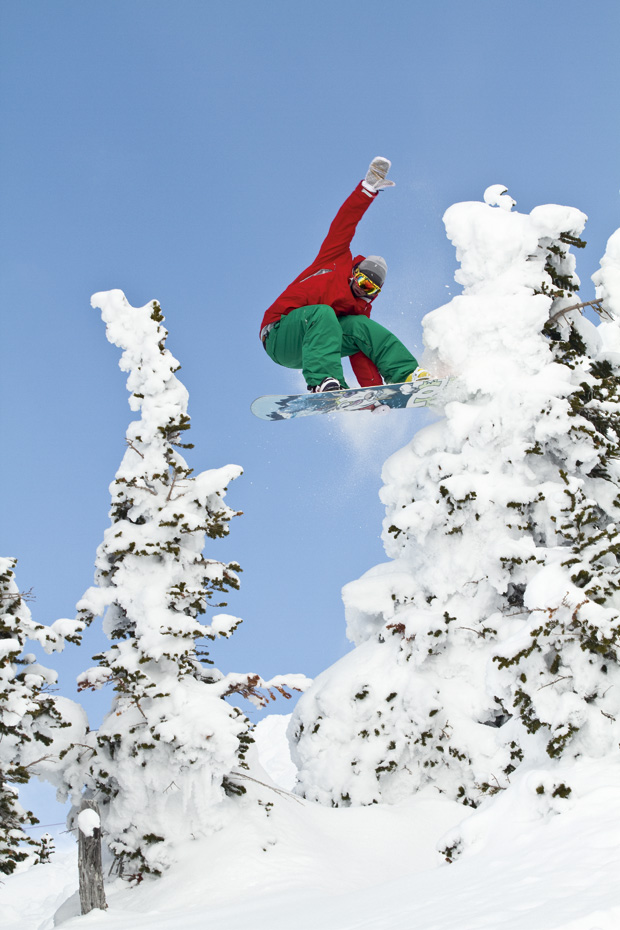
A little further down the narrow sides of the pass widen and a flat valley opens up ahead of us. As we drive through a small homestead, we decide to stop for photos. The sun, still low in the sky, is being filtered through some clouds making the hoar frost on trees sparkle. Vern doesn’t usually get that excited about anything – not even his bangin’ action shots – but he shades the screen on his camera and shows me a clump of wild grass casting shadows on the snow. “It’s fackin’ stunning eh?” We’re going to be late for our appointment with our local guide, but we’ve ceased to worry too much about that. We’re getting into this, loving the emptiness of the roads, the sensation of space, the feeling of freedom. Sam and Col swing the car back into the middle of the highway and get out, standing on the roof and punching the air. They’re there for several minutes before the next passing trucker gets close enough to beep his horn and move them on.
The rest of the road to Targhee is straight, and relatively straightforward, travelling through flat fields criss-crossed with snowmobile tracks and dotted with the occasional bit of broken farm machinery. At one stage, a long-dead drive-in cinema looms up over the horizon. The nearest towns are barely more than single cross-roads surrounded clusters of wooden clapboard houses – when was there ever enough of an audience to make building the screen worthwhile? Tuning into the local radio station (“did none of you useless fackers bring an iPod?” asks Vern) we find ourselves nodding our heads to country-tinged American classics – The Eagles, The Grateful Dead and Jimmy Buffet’s Margaritaville. We’re sitting in the shadow of the Rockies, but it’s easy to imagine this empty landscape stretching on for thousands of miles across the Great Plains.

“I’m just going for another lap lads, alright?” I’ve just popped off the top of the lift and I’m shouting up into a cluster of stunted-looking pine trees buried under thick, mushrooms of snow, behind which the crew are busy building kickers. Sam’s head, red-faced from shoveling snow, pops up nearby. “Yep, all good dude.” As I tear down the short, wide pistes of Grand Targhee, popping in and out of trees and spraying up snow between the cat tracks, I wonder whether I’ll try and squeeze one more in before I stop and help them build. Tearing down a gully and slashing the sides as I go, I figure it would probably be rude not to. There’s so much fun stuff to shred here! Especially since we’ve spent what was left of our morning being guided around by local legend – and former halfpipe champion – Rob Kingwill. He’s endlessly enthusiastic about showing us the resort, pointing out potential spots to hit. And with his own photographer friend Angel in tow, he’s now getting stuck into shooting amongst the trees himself. By the time I get back up to the top, the boys are waiting for intervals of light to break through the gaps in the clouds so they can launch themselves over the trees and into this article. When the light begins to fade and the legs begin to get tired, we pack up and shred down to the bar at the bottom together, ripping through the gulleys and boosting off every tiny hit on the way.
Grand Targhee itself is relatively small – a few apartment blocks and hotels clustered around the bottom of the three main chairlifts – but the bar at the bottom is packed. As we get stuck into pitchers of the Snake River lager and tuck into massive plates of tasty Wydaho Nachos – we’re on the Wyoming-Idaho border and we’re told we have to try ‘em – we get chatting to the people around us. Many of them come back to this resort year after year, praising the small, local feel and enjoying the fact that the snow is tracked less quickly than in Jackson Hole itself. Vern meets a local dude rocking a flat cap and carrying an original Sherman Poppen Snurfer. And when a couple of bands from down the valley plug in and start playing, we take an executive decision to skip dinner and keep going. The only person who isn’t feeling great all this is Col, who returns from the bar with a hangdog expression and the news that there’s not a single place in the resort that sells cigarettes. In fact, I’m told by a seasonaire on a chairlift the next day that the whole resort, including outside areas, is supposedly smoke-free. It’s not just Targhee either – smoking is not the done thing in Wyoming. Shotguns seem easier to come by than cigarettes!
Who the hell are you?’ isn’t the friendliest greeting I’ve ever heard, and things pretty much go downhill from there”
The following morning, my head lets me know in no uncertain terms that the decision to skip dinner was the wrong one. We find ourselves keeping Rob and Angel waiting once again. Thankfully, Rob is waiting for his friend Kevin as well, who’s going to be joining us that day. Kevin, it transpires, is Kevin Jones. Yes, that Kevin Jones. Famously, the man who was arguably snowboarding’s first superstar (well before Shaun White) ended up ‘over it’ and, in a Johan-esque maneuver dropped off the radar and retired to Jackson. Having been off the scene for years, Kevin is making a return to snowboarding with a part in Standard Films’ The Storming this winter. But despite being very much a big deal, in person Kevin is a quiet, unassuming dude. He’s also, much to Col’s delight, a smoker.
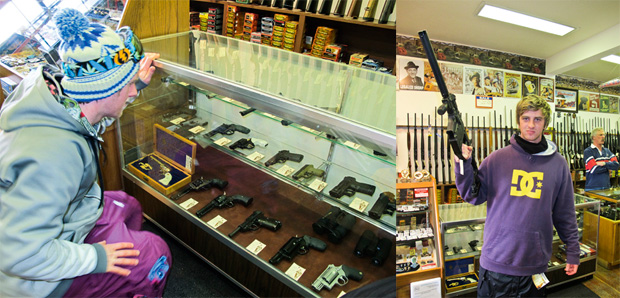
KJ and Rob have decided to lead us to a cliff band just off the back of the chairlift. And this is where we start to see why these boys love riding Targhee – beneath us stretches a massive backcountry zone with kicker spots dotted everywhere. Away to our left, we can see a monster gap that’s obviously been sessioned since the last snowfall, and below us there’s the remains of several older kickers. To our right, there’s the insane 240-foot cliff that a bonkers skier named Jamie Pierre dropped off just to break the world record. Amazingly, despite landing with a plop on his back in the powder below, he survived. Kevin and Rob begin dropping the more modest cliffs in front of us, and it’s impressive how easy they make the 30-foot plunges into powder look. Like Guch, Kevin is a calming and encouraging presence, coaxing a hungover Sam into dropping a beast of a cliff – bigger than anything he’s hit before! Meanwhile Col and myself start work on a kicker that takes most of the afternoon to build, only for us to have to abandon it as the light dips over the ridge. Our hangovers have counted against us perhaps, but it’s still been a good day. Nonetheless, we decide we’ll definitely be eating dinner that night. As we tuck into massive bowls of pasta in one of the resort restaurants (complete with possibly the biggest moose head I’ve ever seen on the wall) one of the waiters introduces himself. “How long are you guys going to be around for? Oh really? Tomorrow? Shame. Did you see that kicker over the back? Yeah we call that Jed’s gap. We pretty much build it every year. It would’ve been cool to session it with you guys, shame you’re not sticking around.” “Oh, I’m Jed by the way” he adds as we part. Locals are like that here.
Driving back the right way to Jackson takes all of an hour. We head over a different but equally beautiful pass in bright sunshine, stopping at a random point on the side of the road to take advantage of an untouched powder bank. It seems there’s potential shred spots anywhere you go here! We’ve been toying with the idea all week, and now we decide that we’ll definitely be taking snowmobiles out when we get back. And so, after a chilled day cruising the pistes, sessioning the impressive park and generally messing about on the awesome terrain Jackson Hole has to offer in-bounds, we head to bed early, ready for a full day of proper back-country riding.
Our final day of riding dawns bright, and as we head down to the sled rental place, spirits are high. Jenny reckons her knee is feeling strong enough to handle a few runs, and is coming with us. Sam in particular cannot wait to get going. As we pull off the road onto the access track, he leaps up onto the trailer and drives the first sled down onto the ice-covered tarmac. I stand next to the trailer shivering slightly in the cold crisp dawn and fiddling with my boots. I’m not letting on too much, but I’m feeling a little bit nervous about the whole thing. I’ve ended up in A & E riding a push-bike before and these sleds look big, powerful and expensive. On top of that, Vern’s been filling our heads with horror stories of how hard they are to ride – and how easy they are to crash. Not that Sam seems to have noticed. He’s roaring up the frozen road, power-sliding his machine round 180 and then haring back towards us with a huge grin on his face. “Guarantee he wrecks that thing before the end of the day”, mutters Vern.
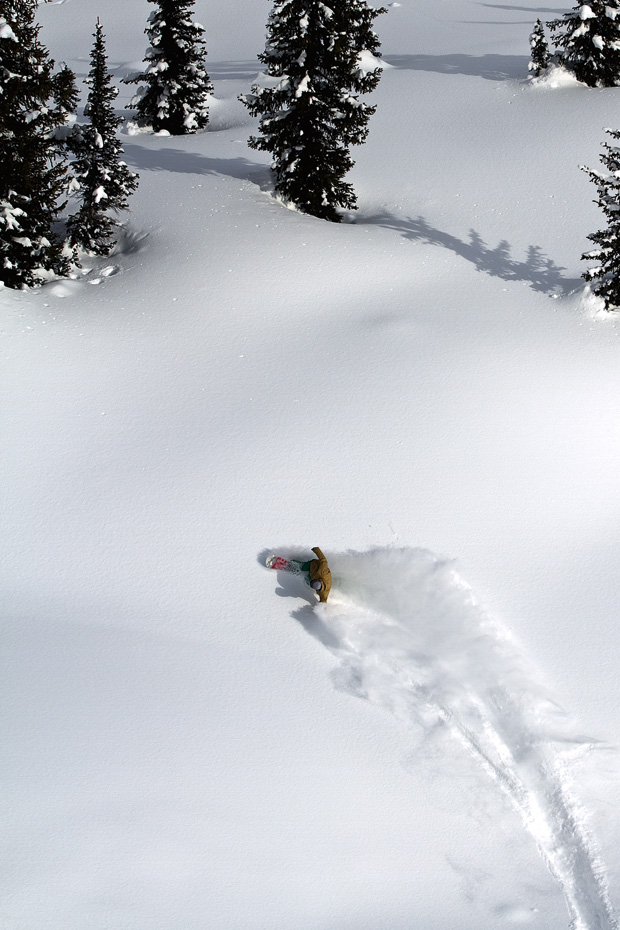
As we head up the gently winding trail and through a burnt forest, I wonder what I was worried about. This is easy sledding. As long as you’re on relatively flat terrain, a snowmobile is one of the simplest things in the world to ride. On these 600cc sleds, the equivalent of dirt bikes, the controls are beyond basic – there’s a pull starter, a throttle, a bicycle-style squeeze brake, and that’s about it. Oh, there’s heating controls for the hand-grips as well, which turn out be totally necessary, because it’s bloody freezing in the wind when you get speed up. In general, I’ve been surprised with how mild the temperatures are in Jackson – OK it’s colder than most European resorts, but this is the first day I’ve needed to wear the facemask I brought with me. I bump along the trail breathing the taste of the morning’s coffee into the fabric and telling myself: “A trained monkey could do this.” At one stage I turn round to check that Col is still behind. As I turn back I see that Sam has stopped, and I can’t quite brake in time. But the sled slows down so that when I do touch him, it’s little more than a gentle nudge. Minor. Nothing serious.
It turns out sledding in powder is a totally different story. We don’t have to do any of the difficult business of breaking trail – forging the first sled track through new snow – that’s been done by another crew already. But turning a sled – even one of these small ones – is a challenge in any kind of soft stuff. You have to transfer all your weight to one side, grabbing the loop between the handlebars and leaning like hell to get the bastard thing to around. We spend a frustrating, but very entertaining, half an hour ragging around an open powder field trying to get the hang of it before we crack on. For all Vern’s dire warnings, Sam is the only one who manages to get through the whole day without getting his sled stuck and having to be dug out – a time consuming process that means we arrive at our destination a lot later than we meant to.
Skirting round a massive, open powder bowl, we spot a couple of sizeable kickers, and wave to the crew filming as we ride past. We stop on the edge of the bowl, and are just admiring a couple of powdery banks to slash when two sleds roar into life below us. The welcome we’ve had from everyone in Jackson – from lifties, and sled-rental people to pros – has been incredible. But these two are less than happy to see us. “Who the hell are you?” isn’t the friendliest greeting I’ve ever heard, and things pretty much go downhill from there. These guys are locals, and they’re pissed that we’ve chosen ‘their’ zone to ride in. Pissed off in a way that would put even the most fiercely protective ‘don’t ride my wave kook’ surfers to shame. We’re isolated, a long way from home, and, being un-used to this kind of tribalism, we’re unsure of where we stand. We haven’t come across it so far, but maybe that’s the way things work out here in the Wild West? “There are sled-necks out here”, says Vern as we turn and ride off, “who ride across all the good snowboarding spots, ruining them for film crews. These days some of film crews carry guns.”
Riding back to the next bowl we make the most of the time we have left. Sam relays Col and Jenny round to the top of the slope, and all three get stuck in slashing pow left right and centre. But there’s a dark cloud that follows me around for the rest of the day. Finding out that my earlier nudge of Sam has torn a chunk out of the fibre-glass on the front of my sled does nothing to improve my mood. Especially when I’m told they’ll have to replace the entire hood – the price? A cool $1,000.
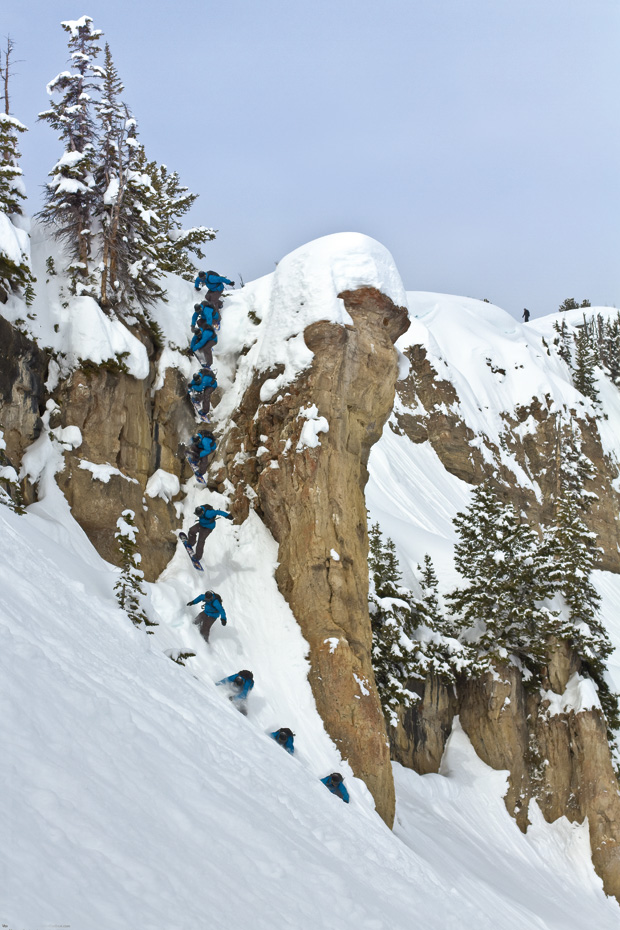
Wandering around Jackson on our last day, I feel more philosophical about the whole affair. We dip into tourist shops, buying novelty mugs and presents to take home. Col puts on a cowboy hat, and Sam poses with a stuffed bear – if you’re not man enough (or just not good enough) to shoot your own grizzly they’re offering ship this one out to you for a mere $15,000. I try to imagine the kind of person who’d buy a ready-killed bear so they can claim they shot it, and struggle to think what they would be doing in Jackson. Because while some of the stuff here is purely put-on for tourists, my over-riding impression has been that Jackson is still the real deal. This is a place where people still make a living as ranchers; where round-ups are not something you watch in Western films, but something that happens every year. It’s a place where horses are not for little girls to groom and feed carrots to, but for grown men to ride. Round here, the mountains are big and scary, and most of the sleds are not toys, but essential tools. The locals are fiercely proud, and you can be a snowboarder dude and still carry a gun.
It’s not all gnarl – as a family you could spend endless amounts of time cruising Jackson’s intermediate runs without ever having to venture into the backcountry. But there’s an edge to both the town and the mountain that makes it feel authentic. In the two weeks we’ve been here, we’ve watched wild coyotes trotting up the sides of those same intermediate pistes, and driven past countless signs warning of the dangers of wild moose crossing. This is the kind of place that pros jaded by the bullshit surrounding a life in the limelight choose to retire to when they want to enjoy the simple joys of shredding. And it’s a place where, if you treat them and their mountain with respect, the locals will welcome you with open arms.
On one of our last evenings in resort, we head to Teton Thai – the restaurant owned by Guch’s brother-in-law. It’s a tiny gem of a place tucked away down an alley, where a mother and daughter team whip up authentic Thai food right in front of you. Earlier in our stay, we’ve spent an amazing evening clustered around the small serving counter sinking bottled beers and trying to persuade Sam to try the hottest curry on the menu. The tiny TV at the end of the bar is showing the women’s Olympic halfpipe final, and although everyone’s watching it, the atmosphere is relaxed. They’re all backing the US, but no-one seems too fussed when Hannah Teter, the last of the yanks to drop, crashes out, giving Torah Bright her well-deserved gold medal. As Jenny whips out her phone to congratulate her friend, I find it hard to believe that what we’re watching on the screen – the tears, the cheers and the whole mad media circus – has anything to do with us. Sitting here, in what feels like a warm and friendly living room somewhere out west, that hectic, high-pressure world feels a long way away.
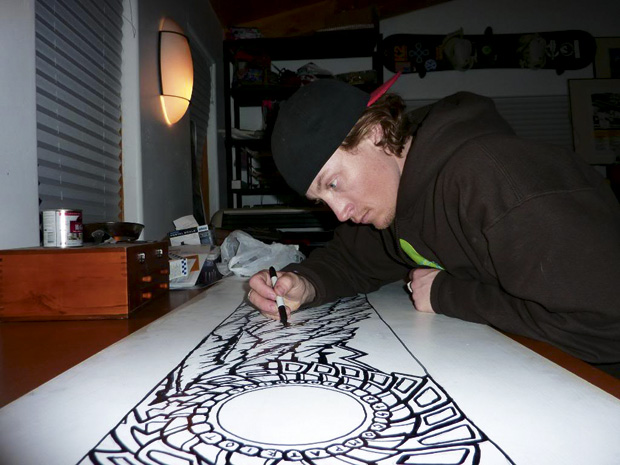
Compatriot Snowboards
Compatriot is the brainchild two Jackson legends, Rob Kingwill, and Kevin Jones. Kinger, as he is known, was one of America’s top halfpipe riders in the late nineties, regularly ending up on the podium at World Cup events. He was also credited with inventing the Sato Flip, an inverted frontside 540 in the pipe. Kevin Jones dominated competitive snowboarding in the early 2000s, winning ‘Rider of the Year’ three times in a row, and snapping up X Games medals for fun. These days, the two of them have turned their hand to freeriding – Rob has bossed the North Face Masters tour in recent years. Between them, these boys have every facet of the industry, both good and bad. So when they decided to start up a brand together – inspired by Jackson and it’s surroundings – the two of them set out to do it right. As Kinger puts it: “It isn’t diluted by some giant ad firm, we’re authentic snowboarding”. Kevin explains: “It’s time to think about the dollar less and the sport more.” It’s still early days – the pair are putting out a limited line of six boards this winter, and none are yet available in the UK – but their down-to-earth approach means they’ll surely go far. Find out more at compatriotsnowboards.com
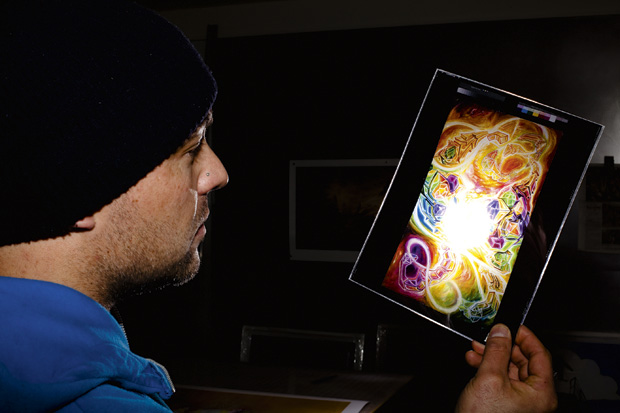
Asymbol Gallery
Asymbol is the joint project of former pro-rider and artist Mike Parillo, and Jackson Hole’s golden child Travis Rice. Based out of a large warehouse-like studio space on the outskirts of Jackson, the gallery aims to collect and display some of the great art that has featured on snowboard graphics over the years, and promote the work of the artists associated with the sport. As Mike explained: “I feel like it’s been done a for surfing in some ways. It’s definitely been done in skateboarding, but it hasn’t really been done for snowboarding.” Asymbol functions mostly as an online gallery, selling limited edition numbered prints of classic work, but they’ve also staged various exhibitions around the world. See asymbolgallery.com for more info.


